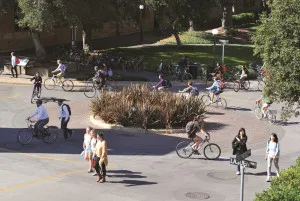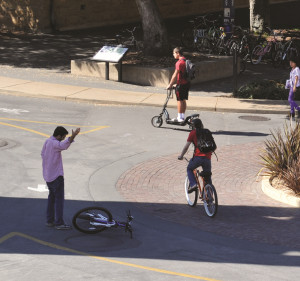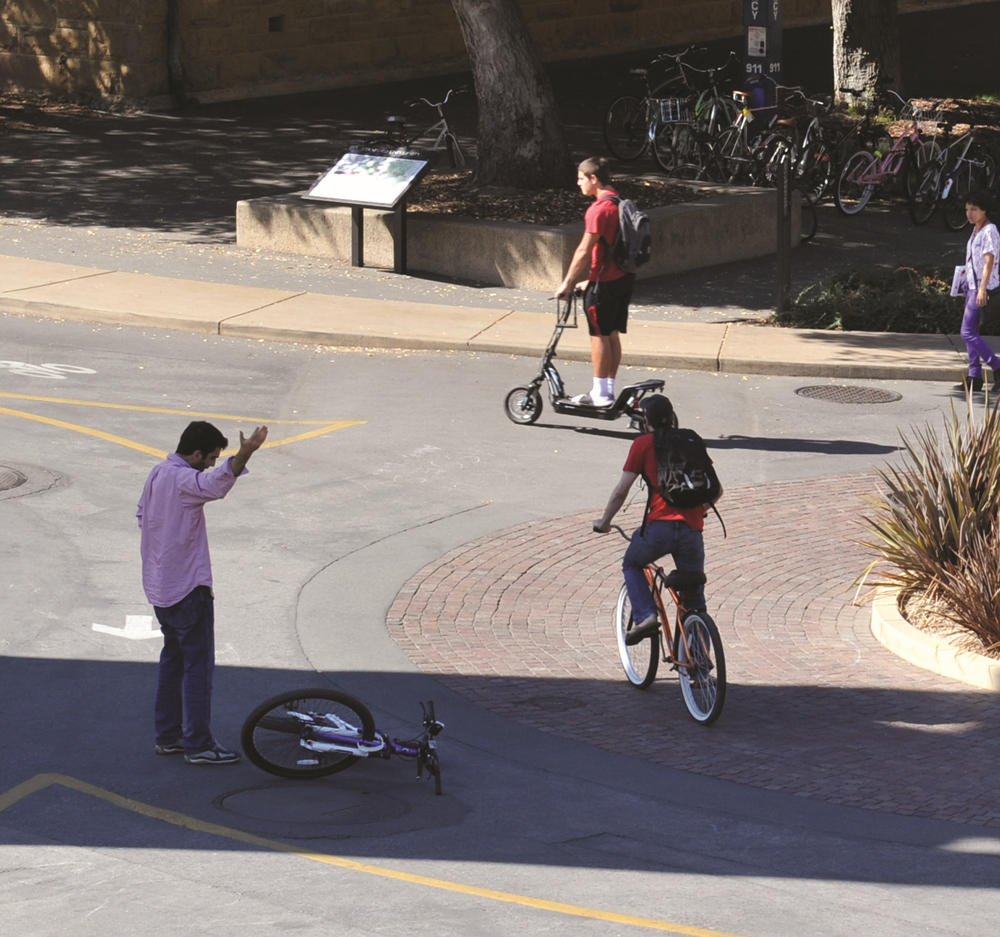Hundreds of vehicles zoom around a circle, trying to avoid each other and reach their destinations as quickly as possible. No, it’s not NASCAR, it’s Stanford’s notorious “circle of death,” the traffic circle near the Clock Tower that is perennially clogged with bicyclists during peak traffic times.

Deputy Allen James of the Stanford University Department of Public Safety (SUDPS) uses an apocalyptic film to describe another treacherous intersection — Serra Street and Arguello Way near the Knight Management Center.
“[Watching ‘World War Z’] would give you a good idea of what the Serra and Arguello Street intersection is like at 10 minutes of the hour,” James said. “It’s pretty much crazy.”
According to SUDPS Deputy Chris McIntyre, these two locations are among those where bike traffic laws are most frequently flouted.
McIntyre is one of five deputies who regularly patrol the campus on bikes.
“We’re out there at the intersections, especially the [problematic] ones, and we’re writing citations,” McIntyre said. “Our reason is not to be punitive, but to get that point across: Safety is our goal, and education if that’s what’s needed.”
Although the SUDPS keeps statistics on bicycle collisions, it’s difficult to know the exact numbers because accidents are widely underreported, according to James.
“We don’t really trust [the statistics] too much, because most people do not report the accidents,” he said. “We maybe get 10 percent [of accidents] reported to us.”
James estimated that more than 300 cyclists are seriously injured while riding on campus each year.
Safe Biking Practices
McIntyre advised that stopping at stop signs and being aware of one’s surroundings are the two most important steps cyclists should follow to be safe while riding on campus.
“If you do those two things,” McIntyre said, “you will probably make it through your time here without significant injury.”
McIntyre also said that cyclists should maintain their brakes, keep tires properly inflated and anticipate possible mistakes by other cyclists or drivers.
“And don’t hit things,” added James.
James said that in 2011-2012, SUDPS issued 1680 bicycle citations.
In an effort to encourage safe biking practices, James started the department’s bike diversion program in 2008. Under the program, those who receive citations for violating bike traffic laws may, once every 18 months, attend a safety class in lieu of paying the fine for their citations.
To date, more than 3,500 people have attended the bike diversion program’s safety classes, which are also open to the public. Those interested in attending may sign up on the SUDPS website.
“Our enforcement efforts aren’t intended to be punitive,” McIntyre said. “They are intended to be educational and safety-based. We take far too many people to the hospital due to these types of things. Almost every time, it is the cyclist’s fault.”
Protecting students’ brains
James also highlighted the importance of wearing a helmet while riding a bike. According to the Department of Parking and Transportation Services, just 11 percent of undergraduates wear helmets consistently, while 40 percent of graduate students wear them.
Several University organizations have partnered to subsidize helmet purchases for freshmen. Residents of all freshmen dormitories may purchase a $30-$40 helmet for a subsidized price of $5. Other members of the Stanford community can purchase subsidized helmets for up to a 40 percent discount at the Campus Bike Shop.
According to Bicycle Program Coordinator Ariadne Scott, the program was launched by Kali Lindsay ’12, who suffered a brain injury after a bike crash. Scott said Lindsay began sharing her story to encourage students to wear helmets for every ride, no matter how long.
The helmet subsidy is supplemented by the Bike Safety Dorm Challenge, in which freshman dorms compete for the largest number and greatest proportion of residents signing a pledge to obey traffic laws and wear a helmet while riding.
The competition will run until Dec. 17. On that date, the dorms leading in each category will receive a free bus charter to Lake Tahoe. At press time, the Freshman-Sophomore College (FroSoCo) was leading in both categories.

Some students don’t need an incentive to wear a helmet.
Eric Smalls ’16 said that he started wearing his helmet at the urging of a friend after his freshman year.
“I think it’s really important to have bike safety,” Smalls said. Smalls noted that students are putting such an investment in their time at Stanford that it would be a mistake not to protect themselves.
Nick Xu ’15, a resident advisor in Twain, described similar reasons for his own decision to start wearing a helmet.
“What’s the most precious thing that I possess?” Xu asked. “It’s the thing between my ears. So why am I not protecting it properly?”
First-year graduate student Therice Morris agreed. “I’m here for my brain, and I want to keep it safe.”
Xu described the difficulties he has encountered while trying to persuade others to wear their helmets.
“No matter how much you preach, you’re not really going to convince others,” Xu said. He said that he now tries to lead by example by consistently wearing his helmet, even for the shortest of trips.
For many, seeing the consequences firsthand is the most effective stimulus.
“Two people in my dorm already got into accidents in the past week,” said Jessica Zhao ’17, “so I just want to wear a helmet to be safe.”
Contact Sam Kurland at kurlands ‘at’ stanford.edu.
